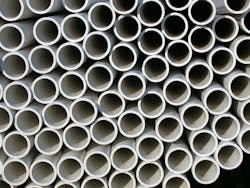DIPRA Announces New Life Cycle Cost Analysis Model
The Ductile Iron Pipe Research Assn. (DIPRA) announced a new life cycle cost analysis model for utility officials and professional engineers. Developed by a research team at the University of Michigan, the tool can be used to evaluate multiple factors affecting pipes, thus allowing them to determine cost-effectiveness beyond initial expense, including costs associated with environmental impacts.
"It is important to consider more than one factor in selecting a pipeline material," said Carol C. Menassa, Ph.D., University of Michigan Civil and Environmental Engineering Department. Menassa is the lead researcher of the project. "With this new tool, the true value of the pipe, as an asset, can be understood, allowing for investment to be made in a good way."
Menassa noted that the life cycle cost assessment (LCCA) tool allows for different pipe sizes, flows and locations, which provides a framework for analyzing various operations and service life scenarios.
Developing the LCCA model was a primary objective of the University of Michigan research paper published by the American Society of Civil Engineers (ASCE), "A Framework to Evaluate Life Cycle Costs and Environmental Impacts of Water Pipelines." Presented by Menassa at the ASCE 2016 Pipelines Conference, the paper compares two of the most common pipe materials used in water systems, ductile iron pipe and polyvinyl chloride (PVC) pipe. Results of the research show that while PVC pipe may have initial cost benefits, ductile iron pipe is the more cost-effective material over the pipeline's service life. Of note, there is a sharp rise in a cost break-even graph analysis of the two pipe materials due to the shorter service life of PVC pipe, which then requires replacement.
Because PVC pipe has a limited performance history, the University of Michigan research team conducted an extensive literature review on reported service lives of both PVC and ductile iron pipe. From the studies, the research team set service lives for PVC pipe at 50 years and ductile iron pipe at 100 years. However, users of the LCCA model can make adjustments to test any service life option. Other findings of the study showed that ductile iron pipe has a lower environmental impact—based both on the production and operation phases of the alternatives—and the rate of pumping across all pipe diameters has the highest impact on cost.
Research on both economic and environmental impacts is important for utility decision-makers as they seek to balance fiscal concerns over immediate and long-term needs. This also affects information on the environmental impact of pipeline materials across production, design, installation, operations and maintenance, and planned end of life. For local government leaders, utility officials and engineers designing pipeline systems, the LCCA model serves as a tool to test various scenarios to determine the right solution for site-specific conditions and community values, as well as for providing the necessary defensible data to support those decisions.
In addition to Menassa, the research team included Albert Thomas and Bharadwaj R.K. Mantha. Data for the LCCA model was obtained from various participating U.S. utilities, and the literature review information was obtained from associations including, but not limited to, the American Water Works Assn. (AWWA), ASCE, DIPRA, the Plastic Pipe Institute, the U.S. International Trade Commission, the U.S. Environmental Protection Agency (EPA) and the Water Research Foundation. DIPRA sponsored the research project.
A copy of the University of Michigan paper can be obtained here from the ASCE library under Conference Proceedings for Pipelines 2016: Out of Sight, Out of Mind, Not Out of Risk.
Source: Ductile Iron Pipe Research Assn.
